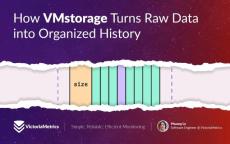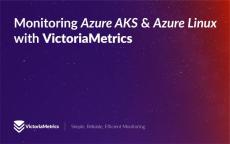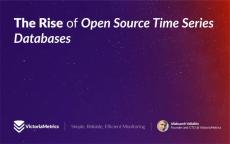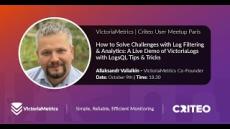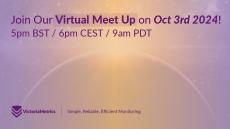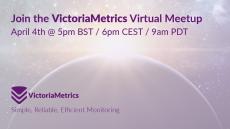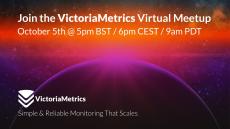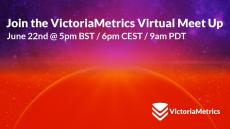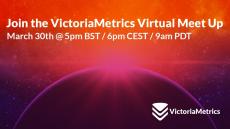We’re happy to announce that VictoriaMetrics, open source time-series database and monitoring solution, and IHI Terrasun Solutions, a leading energy storage system integrator, have partnered on one of North America’s largest clean energy projects! The Gemini Solar + Storage project, which is carefully situated on less than 5,000 acres, is designed to provide clean energy for up to 10% of Nevada’s electricity needs during peak use times.
|
By Phuong Le
vmstorage is the component in VictoriaMetrics that handles long-term storage of monitoring data. It receives data from vminsert, organizes the data into efficient storage structures, and manages how long data is kept. Before vminsert even sees the data, agents are out there collecting it, these agents gather metrics from different sources, hold onto the data briefly, and then send it over to vminsert in batches.
|
By Phuong Le
How vmagent Collects and Ships Metrics Fast with Aggregation, Deduplication, and More.
Salt Lake City, Utah, 13th November 2024 – Today we’re delighted to announce the GA release of our innovative logging solution - VictoriaLogs. Our easy-to-use, open source log management solution combines a powerful query language for easy log searching with minimal resource requirements. It’s perfect for managing and analyzing large volumes of log data, especially in containerised environments such as Kubernetes.
|
By Fred Navruzov
With this blog post, we continue our quarterly “What’s New” series to inform a broader audience about the latest features and improvements made to VictoriaMetrics Anomaly Detection (or simply vmanomaly). This post covers Q3'24 progress along with early Q4 to accommodate a slight shift in the publishing schedule — why not take advantage of it? Stay tuned for upcoming content on anomaly detection.
|
By Zakhar Bessarab
Azure linux is a Linux distribution built for Microsoft’s cloud infrastructure. It can be used as a base OS when creating node pools in Azure Kubernetes Service (AKS) clusters. Using Azure linux as a base OS for AKS node pools has several benefits, such as lower resources footprint, faster boot times, and better security.
|
By Aliaksandr Valialkin
Time series databases allow you to store and query metrics efficiently. For example, if you want to forecast load on your servers, or identify intermittent faults with your production services, time series databases can help. Besides infrastructure monitoring, time series databases have been invaluable in finance, IoT applications, manufacturing, and more. Many time series databases, including VictoriaMetrics, are open source.
|
By Zhu Jiekun
Last week, I saw a user asking for help on Slack: Note: The screenshot was taken in the UTC+8 timezone, so the high churn rate at 8:00 AM occurs at 0:00 AM UTC.
|
By Aliaksandr Valialkin
I don’t understand why pure open-source licenses, such as Apache2, MIT or BSD, should be replaced with a source available license in order to increase profits from enterprise support contracts. That’s why we at VictoriaMetrics aren’t going to change the Apache2 license for our products. Our main goal is to provide good products to users, and to help users use these products in the most efficient way.
We’re happy to announce VictoriaMetrics Cloud, a hosted monitoring platform and managed service for metrics that allows organizations to monitor and store large amounts of time-series data, without having to run the underlying infrastructure. At a time when almost every enterprise relies on complex data to run, VictoriaMetrics Cloud delivers the power of the popular VictoriaMetrics open-source time series solution, which has reached 750 million downloads, with enterprise features.
|
By VictoriaMetrics
Aliaksandr Valialkin - VictoriaMetrics co-founder, will be presenting: "How to Solve Challenges with Log Filtering & Analytics.
|
By VictoriaMetrics
1:56:53 Community News AMA 1:42:48 Mathias Palmersheim, VictoriaMetrics Solution Engineer, presents: 'How did I find my job at VictoriaMetrics? Making my own monitoring and logging solution!'.
|
By VictoriaMetrics
Haley Wang, a software engineer at VictoriaMetrics, presented at KubeCon China 2024 on August 22nd, 2024! In her talk, "Building a High-Performance Time Series #Database from Scratch: Optimization Strategies," Haley shared valuable insights and strategies for optimizing time series databases.
|
By VictoriaMetrics
Aliaksandr Valialkin, #VictoriaMetrics CTO present "Strategies for Efficient hashtag#LogManagement in Large-Scale hashtag#Kubernetes Clusters" at hashtag#FrOSCon. Large #Kubernetes clusters can generate significant volumes of logs, especially when housing thousands of running pods. This may demand substantial CPU, RAM, disk IO, and disk space for storing and querying large log volumes. In this talk, we will look into different strategies of storing those logs in #ElasticSearch, Grafana Loki and #VictoriaLogs and examine how we can save 10x or more on infrastructure costs.
|
By VictoriaMetrics
Thanks to everyone who joined us on the date, and thanks to you for watching the recording today! If you have any questions or feedback, please use the comments section below!
|
By VictoriaMetrics
Watch the replay of our live Q1 2024 Virtual Meet Up with the following agenda.
|
By VictoriaMetrics
This one is special: It's our last virtual meet up of 2023 & we're celebrating our 5 year anniversary! Watch the recording here!
|
By VictoriaMetrics
Watch the recording of our 3rd quarterly meet up with the following agenda.
|
By VictoriaMetrics
Watch the recording of our 2nd virtual meet up of the year during which we announced the new VictoriaLogs!
|
By VictoriaMetrics
Watch the recording of the first VictoriaMetrics User Meet Up in 2023 live-streamed on our YouTube Channel. Our Founders team discussed Q1 2023 highlights, including features highlights, the 2023 roadmap for VictoriaMetrics, a first introduction to the upcoming VictoriaLogs - and we finished the meet up with an 'Ask Me Anything' session. Thanks for all the questions and the discussion! Enjoy the recording :-)
- December 2024 (2)
- November 2024 (3)
- October 2024 (3)
- September 2024 (2)
- August 2024 (5)
- July 2024 (2)
- June 2024 (4)
- May 2024 (2)
- April 2024 (1)
- March 2024 (2)
- February 2024 (1)
- December 2023 (3)
- November 2023 (5)
- October 2023 (5)
- September 2023 (1)
- August 2023 (1)
- July 2023 (1)
- June 2023 (2)
- May 2023 (2)
- April 2023 (2)
- March 2023 (2)
- February 2023 (1)
- January 2023 (5)
- December 2022 (1)
- October 2022 (3)
- September 2022 (2)
- August 2022 (1)
- May 2022 (2)
- April 2022 (2)
- March 2022 (1)
- February 2022 (1)
- January 2022 (4)
- September 2021 (1)
- June 2021 (1)
- March 2021 (1)
- August 2020 (2)
- June 2019 (1)
VictoriaMetrics is a fast, cost-effective and scalable open source monitoring solution and time series database typically used for processing high volumes of data and for long term data storage. Discover our state-of-the-art, open source monitoring and observability solutions that deliver incredible performance, ease of use, scalability and (cost-)efficiency.
Our Products:
- VictoriaMetrics is a fast and scalable open source time series database and monitoring solution that lets users build a monitoring platform without scalability issues and minimal operational burden.
- VictoriaMetrics Enterprise is the fastest open-source monitoring solution and time series database supercharged with custom features, expert architectural guidance and priority support.
- Monitoring of Monitoring: For the most well-tuned system, let our MoM service do the monitoring of your monitoring and detect, mitigate and prevent potential issues before they become major problems.
- Managed VictoriaMetrics is an easy-to-configure-and-run solution that removes the extra complexity and maintenance burden typically associated with open source time series database and monitoring solutions.
We Make Monitoring Simple & Reliable For Everyone.



